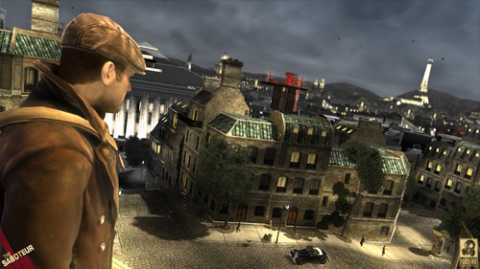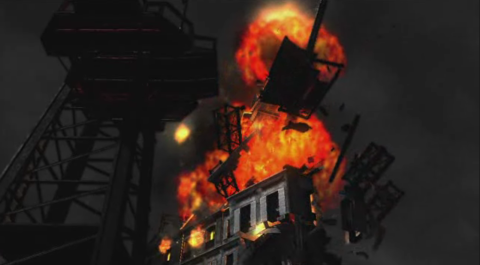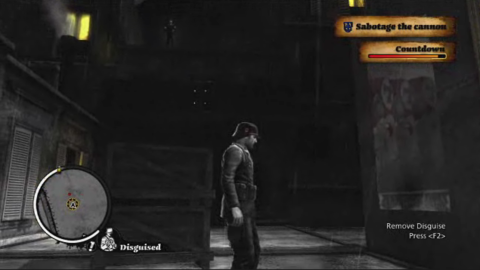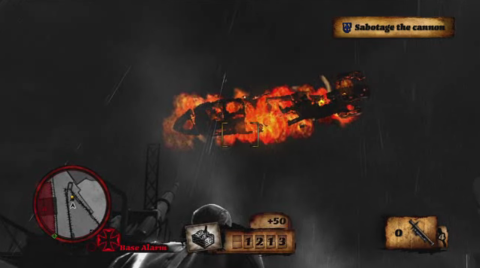
Though set in World War II--more specifically, the Nazi occupation of Paris--The Saboteur is notable for, if nothing else, foregoing the reverent tone most WWII games assume. This isn't Saving Private Ryan; this is more like The Great Escape by way of Inglorious Basterds. This is a two-fisted tale of revenge about an Irish mechanic-turned-race-car-driver named Sean Devlin whose vendetta against a diabolical Nazi officer--the same man that both cheated him out of his first race victory and murdered his best friend right before his eyes--puts him in league with the Parisian underworld, comely cabaret girls, and the French Resistance. It's got an odd tone to it, and the game sometimes has a hard time juggling the tough-talkin' Devlin's personal angst, his multiple femme fatale love interests, his role within the Resistance, and all of the war-time business that actually propels the story forward. The story doesn't pack as much of a punch as it could have, but it sets an appropriate mood for the improbable craziness Sean gets up to.
The big visual trick in The Saboteur is that Nazi-occupied Paris starts off mostly in black-and-white, save for some splashes of color to help identify Resistance and Nazi stuff. It's a striking, Sin City sort of look, though the lack of color cues can make the world a little hard to negotiate. As you liberate portions of the city, not only do the Parisians themselves become more sympathetic to your cause, but color comes back to that piece of the world. Again, not a bad little trick, and the world of video games is built on borrowing clever little tricks like that from other games, but it would've carried more weight if Okami and Prince of Persia hadn't already put it to good use.

Some might take issue with the voice work in The Saboteur, which trades almost exclusively in thickly caricatured European accents. Though voiced by an actual Irishman, Sean Devlin's Irish accent has a syrupy lilt to it that, in concert with his stereotypically short temper, affection for Scotch, and regular use of colloquialisms like “shite,” “arse,” and, I shite you not, “top o' the mornin' to ye,” can make the character feel a little Lucky Charms at times. English, French, and German characters receive similar treatment. While there's no American character in the game, if there were, he'd wear a 10-gallon hat and be called “Tex.” This might be distracting if The Saboteur took itself too seriously, an issue it mostly avoids. The music, on the other hand, requires no such apologies, and The Saboteur gets a lot of mileage out of its main musical theme filtered through various era-appropriate genres. I particularly found its use at the end of the game to be haunting, an adjective I don't throw around too often when it comes to games.
That oddly quiet end sequence, though, is squarely at odds with the not-quite-there quality that permeates the rest of the game. This is an open-world game that gives you very little to do beyond take on missions and blow up Nazi installations, of which there are hundreds scattered across Paris. The missions themselves follow some pretty sturdy open-world formulas of "go here, blow up a thing/kill a guy/steal a thing, get away."
The trick is that you can opt to go about each of these missions in a few different ways. As Le titular Saboteur, Devlin's got four primary disciplines, and most missions are structured in such a way that I found myself regularly using some combination of all of them. He's handy with the hardware, including the firearms he adds to his personal arsenal via a network of black market traders, and that he picks up off the bodies of dead Nazis. Regardless of how you choose to play The Saboteur, you're going to end up in a fair amount of firefights, and the shooting has a nice impact to it. Save for some late-game heavies you encounter, headshots are easy, but enemies work in volume, and the city of Paris is littered with sniper towers, rooftop guards, machine-gun nests, and just Nazis, Nazis everywhere. It can make firefights unpredictable, but it can also be a point of frustration. Devlin can absorb a pretty unearthly number of bullets and his health regenerates, but there were repeatedly moments where I'd go down spinning in circles, unable to figure out where the hell those bullets were coming from.

Many of the missions you'll take on revolve around the destruction of crucial Nazi property, with mission arcs often culminating in you single-handedly hollowing out a large Nazi base, and it's amazing what Sean can do with a few well-placed sticks of dynamite. Despite some fussiness with where exactly you can place explosives, it's admittedly pretty satisfying to walk up to a Nazi tank, casually stick a bundle of TNT to the side, and walk away all nonchalant as it blows up behind you.
Most of the time you can walk around Paris a free man, but if you're too close to an explosion, or a Nazi sees you doing something suspicious, the jackboots will start coming for you in a hurry. Lucky for you, Devlin can be a sneaky Irishman, and there's a lot of very loose, very optional stealth gameplay to be had here. If you manage to take down a Nazi with your bare hands, and without any other Nazis seeing you, you can steal his uniform, making it easier to approach Nazi bases, personnel, and equipment. There's a whole system of gauges and meters and alarm levels and zones and geegaws and jimjams associated with the stealth that makes it feel extremely gamey. I spent a lot of my time during the stealth sequences staring at circles within circles within circles on my minimap. It's a fairly baroque solution, but it mostly works.
Alternately, if dress-up's not your thing, you can bypass some security by scaling the sheer faces of buildings and running along rooftops. It doesn't help that The Saboteur is coming out a few weeks after Assassin's Creed II, which handles urban traversal with preternatural elegance. Even without those comparisons, The Saboteur would still feel a little unreliable. The character movement in general feels twitchy, but trying to negotiate the uneven roof ledges of Paris is particularly nerve-wracking. In all my time with The Saboteur, I never felt totally confident when I approached a ladder.

The gunplay, the sabotage, the stealth, and the proto-parkour are all fun, if not original, ideas, and they're accompanied by additional ideas like the ability to call in Resistance supporters or a getaway car in a firefight, or the ability to turn any car into a rolling bomb, but the ideas never feel like they come together as a cohesive whole. Whenever a new gameplay concept is introduced, it's not streamlined into a mission. Instead, the game comes to a full stop and treats you to several pages of text explaining how the new stuff works. The other sterling example is the way that, when your Nazi disguise has been discovered, it jarringly disappears off Sean's body. That ruins any sense of reality the game might try and establish.
There are also nuts and bolts issues with the tech behind The Saboteur. The frame rate, while mostly inoffensive, bogged down dramatically at one particularly action-packed sequence. The level of detail can be distracting, especially when the bright lights of the Eiffel Tower blink out abruptly at a certain distance. Enemy, pedestrian, and driver AI aren't particularly brilliant, and it's not uncommon to see another driver (or as Sean might say, droivur) trying to negotiate some baffling 16-point turn. At a certain point in my progression, I found that every time I passed a certain tank, it appeared as though it had dropped from about four feet in the air, and was rubbing uncomfortably against a nearby tree. There are a lot of nitpicky little things to snag yourself on in The Saboteur, but they add up.
About the greatest success an open-world game can achieve is to dupe the player into believing, even on a sub-conscious level, that they are in a real place. Deep down, we know that these are all clockwork playgrounds constructed specifically for our amusement, so it's not an easy thing to do. But The Saboteur's gameplay systems never let you forget that you are playing a game, and the nakedness of the underlying machinery is one of the game's greatest shortcomings.